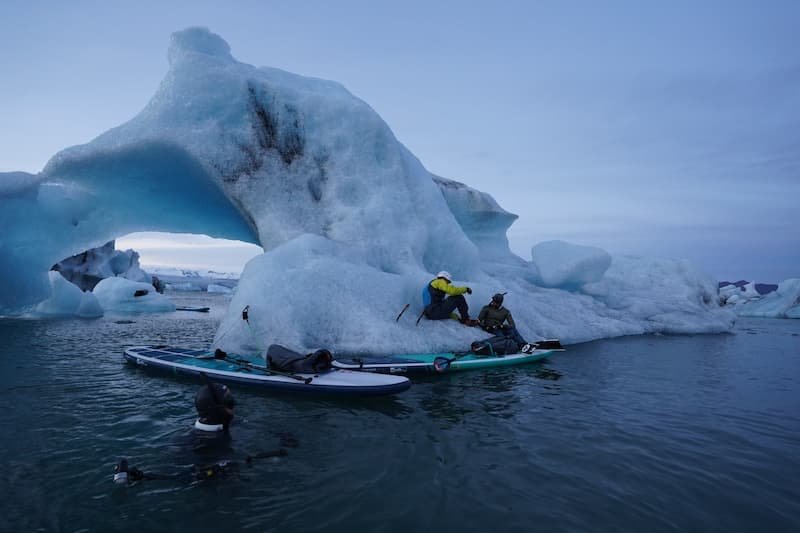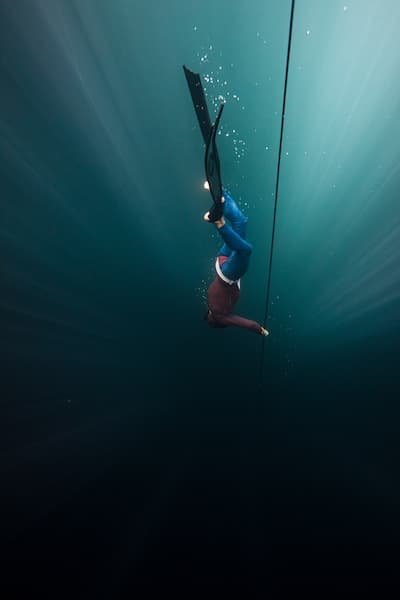
 Nick Pelios
Freediver, Creator
Nick Pelios
Freediver, Creator

 Nick Pelios
Freediver, Creator
Nick Pelios
Freediver, Creator
You’re gliding down the line. Equalizing is smooth, your body is calm, and then it hits. A sudden chill. Your visibility shifts. Your body tenses. What just happened? You crossed a boundary.
Not a metaphorical one. A real one. A line in the water where physics, temperature, and salinity collide. Where science shows its hand and reminds you that the ocean is not just a playground. It is a layered, complex, and reactive environment that responds to depth, heat, salt, and movement in ways that can affect your entire dive.
These layers have names. Thermocline. Halocline. Sometimes they’re separate. Often, they’re stacked together, creating what’s called a pycnocline. If you freedive regularly, you’ve met them. Maybe you just didn’t know what they were.
This article is about understanding those invisible lines and learning how to work with them instead of against them.
A thermocline is a layer in the water column where temperature drops rapidly with depth. You can be diving in what feels like warm soup and suddenly hit a layer that feels like a cold slap to the chest.
Thermoclines form because of sunlight. The top layer of the ocean absorbs heat from the sun, especially in the summer. This warmer, lighter water floats above the colder, denser water below. But the transition is not gradual. It’s sudden. That abrupt drop is the thermocline.
In tropical regions, this boundary might sit as deep as 30 meters. In temperate or colder waters, it can form much shallower. In lakes, thermoclines can form in just a few meters.
A halocline is similar, but instead of temperature, the boundary is about salinity. In areas where freshwater and saltwater mix, think estuaries, fjords, or regions with heavy rainfall, you may experience a halocline. The top layer, often less salty and therefore less dense, rests on the saltier layer below.
Haloclines are less dramatic in terms of temperature, but they can cause major visual distortion. It can feel like diving through glass. You see the line. You swim through it. Everything wobbles for a second, like heat waves on asphalt.
Your mind might panic. You think something’s wrong with your mask or your eyes. It’s not. It’s just physics.

Because these layers are not just curiosities. They affect everything about how your body and mind experience the dive.
They affect buoyancy. Your buoyancy shifts because water density changes.
They affect thermoregulation. Your body reacts to sudden cold by tensing, increasing oxygen consumption.
They affect visibility. Haloclines can cause refractive effects that make it hard to see clearly.
They affect headspace. Sudden environmental changes trigger distraction or stress.
Let’s break those down.
You know that moment when you hit a cold layer and instinctively tense? That’s your body trying to preserve heat. Blood rushes to your core. Your muscles stiffen. You stop moving as fluidly.
But in freediving, tension is the enemy. Tension costs oxygen. Even a brief contraction of your diaphragm can shorten your dive. Your body, trying to protect you, is also working against you.
Experienced divers learn to expect this. They anticipate the cold. Some use it as a trigger to deepen relaxation. If you can drop into stillness when your body says panic, you’re in control.

A halocline doesn’t freeze you. It confuses you.
Visual distortion, murky water, or sudden shifts in light can create unease. You lose focus. In static training, distraction is manageable. In depth diving, it can cause a miscalculation or a loss of orientation.
Some divers describe a halocline as diving through jelly. Others say it feels like their eyes are malfunctioning. It is disorienting if you don’t know what you’re dealing with.
Understanding this helps. So does repetition. Dive the same spot often enough, and the halocline becomes predictable. It becomes a cue, not a threat.
Both thermoclines and haloclines affect water density. And density affects buoyancy.
Say you’re diving in the Mediterranean. At 12 meters, you pass through a thermocline. Suddenly you feel heavier. Your sink phase accelerates. Or, depending on your exposure suit and weight system, you feel lighter. You float more.
This can be subtle, but over time, it affects how you pace your dive and where you initiate your freefall. Some divers misjudge the neutral buoyancy point and burn precious oxygen trying to correct course.
The more you understand the layers in your local waters, the more you can adjust your technique to match.
Here’s what to consider.
Pre-dive research. Ask locals or study oceanographic charts. Thermocline depth changes seasonally.
Train for tension. If your body tightens in cold water, practice deep relaxation and progressive muscle release.
Weighting. Adjust your ballast if you’re consistently diving in multi-layered environments.
Visualization. Include passing through a thermocline or halocline in your mental run-throughs.
Dive slowly. When you expect distortion or cold, descend slower. Give your body and mind time to adapt.
Understanding water layering is not just about performance. It’s about respect. Thermoclines and haloclines create micro-ecosystems. Some fish congregate at the boundary. Plankton accumulate. It is a transition zone of life.
In some fragile areas, thermocline stability is crucial for marine life. Disruption, whether from divers, boats, or warming trends, can shift entire ecosystems.
As freedivers, we move quietly, but not without impact. Being aware of how your presence interacts with these boundaries can help you dive more consciously.
Thermoclines and haloclines are not enemies. They’re teachers.
They teach you to slow down. To observe. To adapt without reacting.
In a world that celebrates force and speed, freediving reminds us that softness is powerful. That noticing a shift in temperature, adjusting to a distortion, and staying present in discomfort are skills worth cultivating.
These layers in the water are metaphors, yes, but they are also real. They shape our experience. They test our discipline. They reward our awareness.
So the next time you feel the cold hit or see the world shimmer, don’t fight it. Welcome it. Because that moment, right there, is where the dive begins.